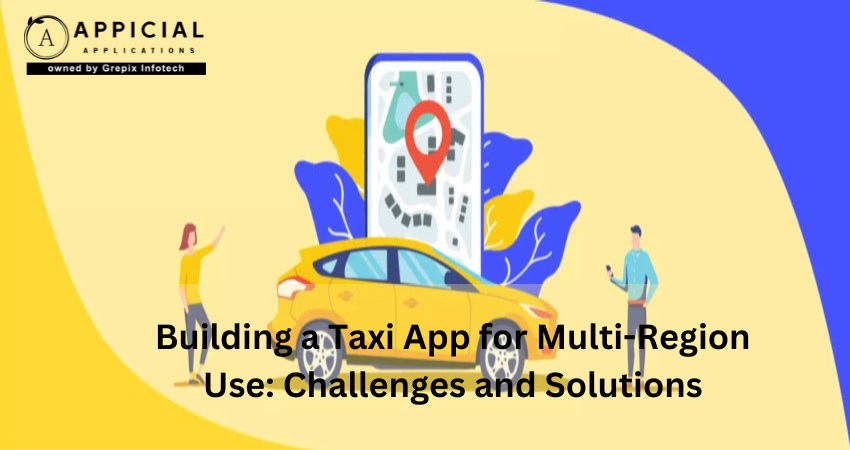
Building a Taxi App for Multi-Region Use: Challenges and Solutions
The transportation industry is ripe for innovation, and taxi apps are at the forefront of this change. As urbanization continues and the demand for convenient transportation grows, there is ample opportunity for new players to make their mark. By focusing on user needs, respecting local customs and regulations, and leveraging technology effectively, your taxi app can not only navigate the challenges of multi-region deployment but also set new standards in the industry.
Creating a taxi app that functions efficiently across multiple regions is a complex challenge that involves addressing various technical, regulatory, and operational hurdles. This comprehensive guide will discuss the key challenges and provide practical solutions for building a multi-region taxi app, drawing insights from industry experts and successful case studies.
Creating a taxi app for multi-region use involves addressing diverse challenges, including localization, regulatory compliance, technological hurdles, payment integration, scalability, and market competition. Effective localization addresses language and cultural differences, ensuring the app resonates with users in each region. Regulatory compliance is critical, with requirements varying across different areas, demanding a flexible approach to legal and data privacy issues. Technological adaptations must ensure GPS accuracy, network connectivity, and cross-platform functionality. Payment systems should accommodate multiple currencies and preferred local methods. Scalability is achieved through robust cloud services and a microservices architecture to handle growing user demands efficiently. This guide outlines practical solutions and strategies, illustrated by a hypothetical case study, to overcome these challenges and create a successful multi-region taxi app.
Challenges in Building a Multi-Region Taxi App
1 Localization and Cultural Differences
- Language Barriers: One of the most immediate challenges is accommodating different languages. Users are more comfortable using apps in their native language, which means the app must support multiple languages, including regional dialects.
- Cultural Barriers: Beyond language, cultural differences affect user behavior. Payment preferences, tipping etiquette, and even the way users interact with the app can vary significantly from one region to another.
2 Regulatory and Legal Compliance
- Licensing Requirements: Different regions have varying regulations for taxi services, including licensing for drivers and vehicles.
- Data Privacy Laws: Compliance with data protection regulations like the General Data Protection Regulation (GDPR) in Europe is crucial.
- Local Transportation Laws: Some regions may have restrictions on ride-sharing services, requiring adherence to traditional taxi regulations.
3 Technological Challenges
- GPS and Mapping Services: Accurate real-time tracking is essential. However, GPS accuracy can vary by region due to differences in infrastructure and available technology.
- Network Connectivity: Ensuring app performance in areas with poor internet connectivity is a significant challenge.
- Device Compatibility: Users may have a wide range of devices with different operating systems and capabilities.
Also Read: Top Taxi App Development Companies in Noida
4Payment Integration
- Currency Support: Handling multiple currencies requires a robust payment system capable of real-time currency conversion.
- Payment Methods: Popular payment methods differ by region. While credit cards may be prevalent in one area, mobile wallets or cash payments might dominate in another.
5 Scalability and Performance
- Server Infrastructure: Supporting a growing user base across multiple regions demands a scalable server infrastructure.
- Latency Issues: Geographical distances can cause latency, affecting app responsiveness and user experience.
6 Competition and Market Saturation
- Established Players: Competing with local and global taxi services requires a unique value proposition.
- Market Research: Understanding the local market demand and user expectations is essential for success.
Solutions to Overcome the Challenges
1 Effective Localization Strategies
- Multi-Language Support: Implement a localization framework that allows for easy addition of new languages. Utilize professional translation services to ensure accuracy.
- Cultural Customization: Adapt the app interface and functionalities to align with local customs and user preferences. This could include customizing color schemes, icons, and user prompts.
- Local Customer Support: Offer customer service in local languages to enhance user trust and satisfaction.
2Navigating Regulatory Compliance
- Legal Consultation: Hire local legal experts to understand and navigate the regulatory landscape in each region.
- Compliance Framework: Develop a compliance framework within the app that can be adjusted based on regional laws. This includes features like driver verification processes and data handling protocols.
- Transparency: Communicate with users about data usage and privacy policies to build trust and comply with regulations.
3 Technological Adaptation
- Advanced Mapping Solutions: Partner with reliable mapping service providers that offer detailed and accurate maps in target regions.
- Offline Functionality: Incorporate offline capabilities to ensure the app remains functional in areas with poor connectivity. This could involve caching maps and allowing certain actions without immediate server communication.
- Cross-Platform Compatibility: Use responsive design and thorough testing to ensure the app works smoothly across various devices and operating systems.
4 Robust Payment Systems
- Multiple Payment Options: Integrate with local payment gateways to offer popular regional payment methods, including mobile wallets, bank transfers, and cash payments.
- Secure Transactions: Implement strong encryption and security protocols to protect user financial data.
- Transparent Pricing: Display fares in local currencies with clear breakdowns to avoid confusion and build trust.
5 Scalable Infrastructure
- Cloud Services: Utilize cloud computing services like AWS, Google Cloud, or Azure for scalable server solutions that can handle variable loads.
- Content Delivery Networks (CDNs): Use CDNs to reduce latency by distributing content closer to the user's location.
- Microservices Architecture: Adopt a microservices approach to make the app more modular and easier to scale.
6 Strategic Market Entry
- Competitive Analysis: Conduct thorough research to understand the strengths and weaknesses of competitors in each region.
- Marketing Strategies: Develop localized marketing campaigns that resonate with the target audience.
- Partnerships: Collaborate with local businesses, drivers, and influencers to establish a foothold in the market.
Case Study: A Hypothetical Implementation
To illustrate these solutions, let's consider a hypothetical taxi app called "GlobeRide" aiming to operate in Europe, Asia, and Africa.
- Localization: GlobeRide starts by implementing English, Mandarin, French, and Swahili languages. To translate and culturally modify the app interface, they employ native speakers.
- Regulatory Compliance: The company consults legal experts in each region to understand local laws. In Europe, they ensure GDPR compliance by implementing stringent data protection measures.
- Technological Solutions: GlobeRide partners with local mapping services in regions where global providers are less accurate. They also develop an offline mode for areas with unreliable internet connections.
- Payment Integration: The app integrates with Alipay and WeChat Pay in China, and M-Pesa in Kenya, and maintains credit card options in Europe.
- Scalability: GlobeRide uses AWS for cloud services and employs CDNs to reduce latency. They adopt microservices architecture to allow independent scaling of different app components.
- Market Strategy: The company launches targeted marketing campaigns, highlighting features like safety and reliability, which are tailored to address the concerns of users in each region.
Importance of Driver and User Engagement
1Driver Recruitment and Retention
- Background Checks: Implement rigorous background checks that comply with local regulations to ensure passenger safety.
- Incentive Programs: Offer competitive earnings and incentives to attract and retain drivers.
- Training Programs: Provide training to drivers on app usage, customer service, and local regulations.
2User Experience Enhancement
- User-Friendly Interface: Design an intuitive app interface that requires minimal effort to navigate.
- Feedback Mechanisms: Incorporate features that allow users to rate rides and provide feedback, which can be used to improve services.
- Customer Support: Offer 24/7 customer support with multilingual capabilities.
3Continuous Improvement and Updates
- Regular Updates: Keep the app updated with the latest features, security patches, and performance improvements.
- Data Analytics: Utilize analytics to understand user behavior and preferences, allowing for data-driven decision-making.
- Adaptability: Stay flexible to adapt to changing market conditions, user expectations, and technological advancements.
Conclusion
Building a taxi app that efficiently operates across multiple regions is undeniably a complex endeavor, fraught with a myriad of challenges ranging from localization and regulatory compliance to technological adaptations and fierce competition. However, as we've explored in this comprehensive guide, these challenges are not insurmountable. By implementing effective localization strategies, navigating legal requirements with due diligence, adapting to technological demands, integrating robust payment systems, and scaling infrastructure wisely, developers can create a resilient and user-friendly multi-region taxi app.
The hypothetical case of "GlobeRide" illustrates how strategic planning and localized solutions can pave the way for successful expansion into diverse markets. Moreover, emphasizing driver recruitment and retention, enhancing user experience, and committing to continuous improvement are crucial for sustaining growth and staying competitive.
At Appicial Applications, we understand the intricacies involved in developing such complex platforms. Our expertise lies in crafting tailor-made taxi app solutions that not only meet but exceed the expectations of users and stakeholders across different regions. We believe that with meticulous planning, cultural sensitivity, and technological innovation, it's possible to overcome the hurdles and build a taxi app that thrives on a global scale.
Let Appicial Applications be your partner in this ambitious venture, turning complex challenges into streamlined solutions for a globally efficient taxi app.
Looking out to start your own venture like Uber? Try out our HireMe Uber Clone, the easiest way to kick-start your taxi business.






